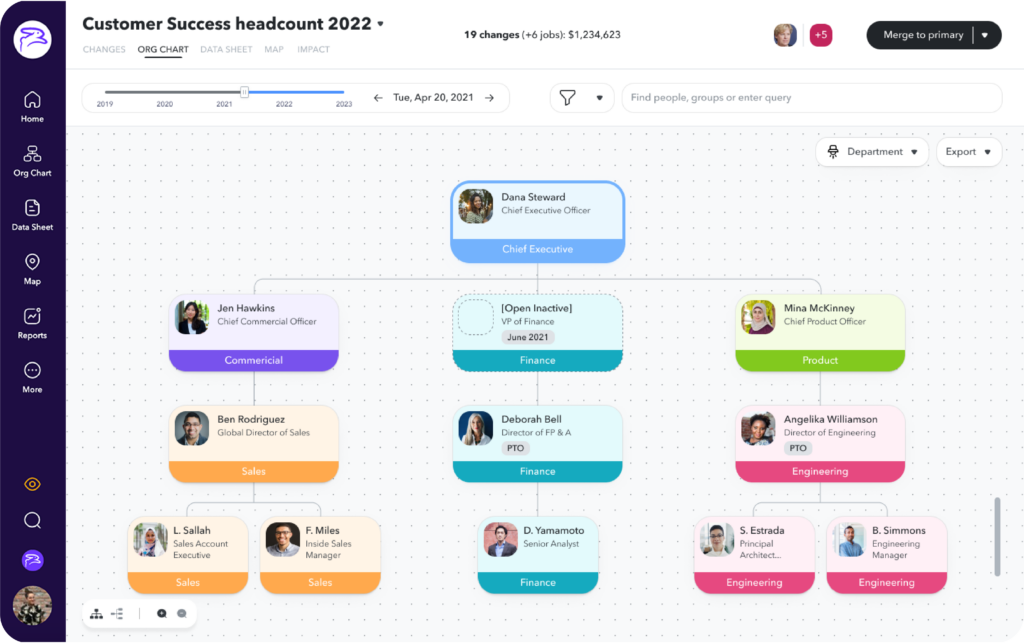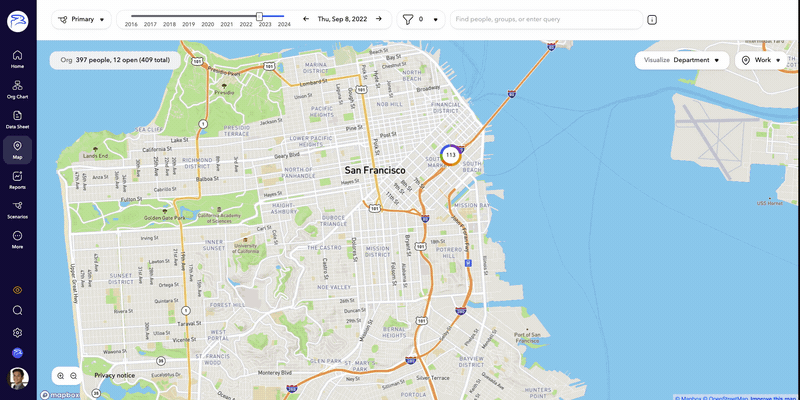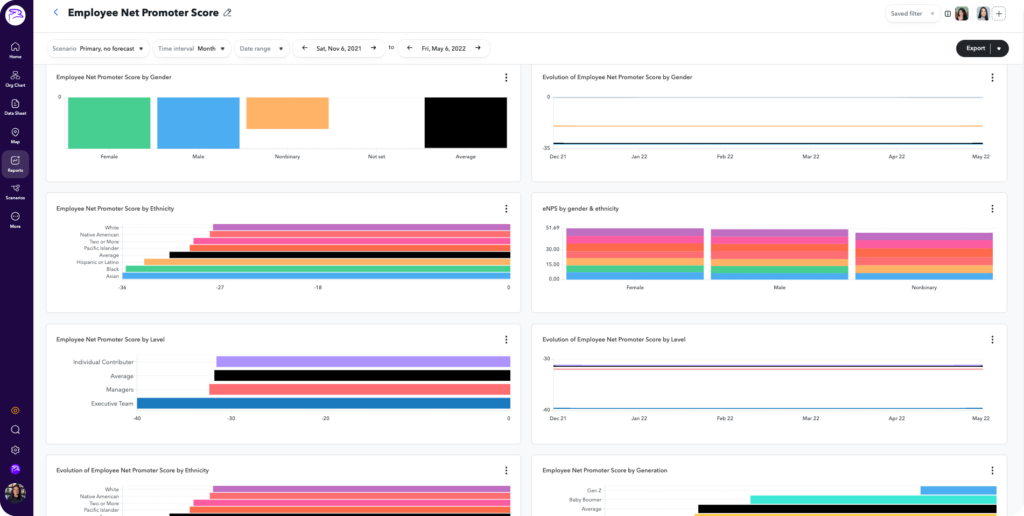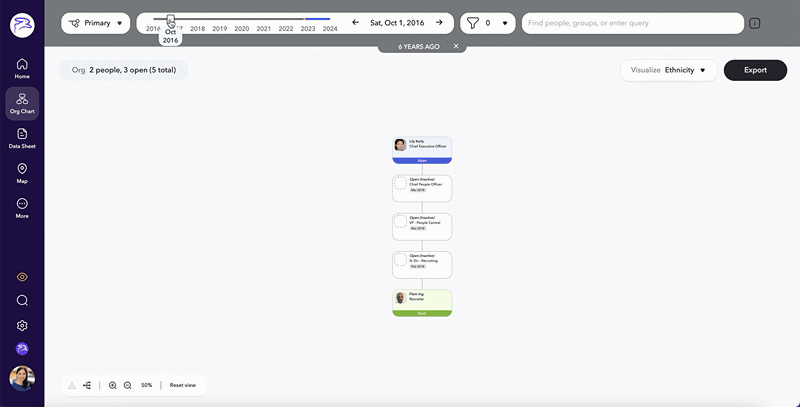
Finance is one of the most critical inputs that goes into headcount planning. And yet, CFOs are often brought into the process too late or have only a limited view of ever-changing plans. Sound familiar?
This situation doesn’t make anyone happy – and is actually detrimental to your organization.
Luckily, there’s a solution that helps satisfy CFO responsibilities: a people operations platform. Below we outline four CFO priorities, as well as how a people operations platform helps bridge the gap between that status quo and your ideal scenario.
The ideal: In an ideal world, you and the entire finance team have scenario models at your fingertips. You easily switch between any number of plans to understand the impact of each one on budget, real estate costs, ability to meet growth goals, and more. You visualize what your organization would look like, see a top-line report of those key metrics for each scenario, and then easily approve or reject each plan. You feel like a superhero.
The status quo: In reality, getting your hands on all the potential scenarios — let alone understanding the financial and growth impact of each one — is nearly impossible. The plans you can access are scattered and often missing key information you need in order to understand the complete picture of what org growth will mean for costs, company footprint, and revenue in the coming year.
How to bridge the gap: Introducing a people operations platform that offers scenario planning functionality can shift this process from a time-consuming headache into a value-add for your team (which is especially important given that 66% of FP&A leaders reported spending more time on scenario planning in recent years). The right solution should allow you to view each scenario on an org chart to understand team structure, and then permit you to easily toggle over to see graphical and numerical views of the impact on any number of KPIs. Importantly, your people operations platform should capture changes in real-time so that your team always has the most up to date information. Perhaps best of all, you should be able to easily merge any scenario into the master plan once it has final approval.

Scenario planning within a modern people operations platform makes financial planning and analysis a breeze. With all your people data at your fingertips, you can quickly iterate your plans and request approvals with the click of a button.
The ideal: If everything went right, your team would be able to set budget parameters for different roles and locations for your headcount plans. And everyone involved in the process would adhere to those guidelines so you could accurately forecast how people-related operating expenses would contribute to the bigger picture for the coming year. Headcount plans would include everything from base salary, variable compensation, and equity compensation to hiring timelines for how that will play out during the year. Understanding this balance also requires looking at more than just salary costs: You need to consider any software licenses, office space needs, and stipends such as those for a home office setup or professional development — among many other areas.
The status quo: No matter how much your team communicates budget parameters to managers involved in the headcount planning process, there’s always someone who goes rogue (we hate to admit it, but you know it’s true). And because plans are so scattered, it’s difficult to catch these errors before it’s too late. Additionally, changing timelines and locations for new hires can have a significant impact on monthly expenses and real estate needs that are hard to capture in advance.
How to bridge the gap: Bringing on a solution that can automate and centralize the headcount planning process goes a long way toward bridging this gap. For example, the right people operations platform keeps track of changes across your organization in real-time (including changes in hiring timeline and role level for open headcount) and ties those changes back to costs. This capability gives your team the most accurate data on which to model financial forecasts. Additionally, having access to data like the ability to view employee locations on a map based on existing headcount and open roles can also make a big difference when it comes to FP&A efforts like identifying the need for office space in various locations.

Look at your current headcount reports, employee locations, and open roles to create strategic headcount plans for the upcoming year.
The ideal: Succession planning demonstrates preparedness and agility, and in an ideal world your organization would have clear plans for turnover in critical leadership roles throughout the business. As part of this effort, your team needs to know whether or not there’s anyone internally who could take on those roles based on the required skills and the impact of not filling those roles immediately.
The status quo: Nearly half of companies don’t have any kind of clear succession plans in place, which can lead to serious disruptions for the business both internally and externally. If reading that statistic made you break into a nervous sweat, us too. This fact is particularly alarming because, now more than ever, people are willing to leave long-time employers if their personal and professional needs aren’t met (hence why 81% of CFOs are concerned about high turnover and labor shortages). But we all know that simply worrying doesn’t help any situation; you have to put plans in place so you can respond at any time.
How to bridge the gap: Effective succession planning requires understanding your people data, including employee engagement and performance. The ability to easily access this data and analyze trends in these areas – for example, by looking at eNPS scores, promotion rates, and KPI and goal attainment – can help identify both flight risks and opportunities to promote existing team members. Overall, having a strong pulse on this data can help define succession planning and give your team a clear understanding of potential turnover risks, how you would fill those roles, the time it would take to do so, and the likely impact of that situation on the business.

CFOs need direct access to people data…instead of requesting multiple spreadsheets from the People team. When you’re equipped with the right metrics, you’re better able to create headcount plans that consider who is ready to transition into what role.
The ideal: Your finance team needs to consider how hiring plans will affect the diversity of your organization to ensure that, as the company grows, their demographics reflect any commitments you’ve made to improving diversity and inclusion. Ideally, your team would have easy access to understand the current makeup of your people based on factors like race and gender, as well as the ability to overlay metrics like eNPS scores, attrition, and promotion rates. Access to this data helps identify any negative trends, such as high turnover or a lack of promotions among a particular group.
The status quo: Understanding the demographics of your employees can take weeks. It involves working with your People team to pull data from multiple sources and wrangling spreadsheets to bring that information together. The ability to overlay those details with metrics that speak to engagement, retention, turnover, upward movement, and more is likely out of the question.
How to bridge the gap: Achieving DEIB goals is important, especially since 57% of CFOs report having a workforce that reflects society is a top priority. A people operations platform that centralizes critical employee data, including demographics, engagement, and performance, helps get your team there. This type of solution should unlock data for your team (providing sensitivity controls for different levels of access) so that everyone involved in headcount planning can easily slice and dice data to identify trends and develop action plans accordingly.

With the right people operations platform, you can see the results of your DEIB efforts over time to ensure you’re on the right track.
Overall, when it comes to effective headcount planning, every CFO and finance team needs transparency into what’s going on.
Specifically, you need visibility into all of the potential growth plans and how that looks across teams to ensure your company will be well-positioned to meet key goals. You also need the ability to approve requests and track changes to plans as they happen — not days, weeks, or even months after the fact.
The right solution should not only provide this transparency, but it should also create an easy way for your team to collaborate directly with the People team, executives, and any other managers involved in the headcount planning process. And when that happens, headcount planning can become a valuable business process that empowers your team to strategize more effectively based on expected growth and the many variables that come along with that.
Sign up for a free demo today.